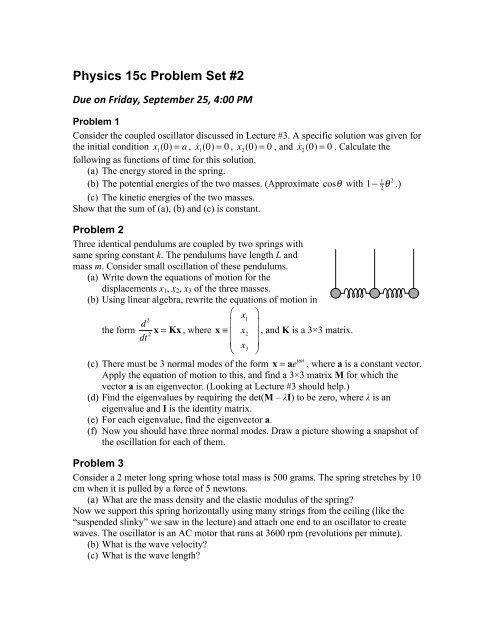Physics 15c Problem Set #2
Physics 15c Problem Set #2
Physics 15c Problem Set #2
You also want an ePaper? Increase the reach of your titles
YUMPU automatically turns print PDFs into web optimized ePapers that Google loves.
<strong>Physics</strong> <strong>15c</strong> <strong>Problem</strong> <strong>Set</strong> <strong>#2</strong>DueonFriday,September25,4:00PM<strong>Problem</strong> 1Consider the coupled oscillator discussed in Lecture #3. A specific solution was given forthe initial condition x 1(0) = a , x 1(0) = 0 , x 2(0) = 0 , and x 2(0) = 0 . Calculate thefollowing as functions of time for this solution.(a) The energy stored in the spring.(b) The potential energies of the two masses. (Approximate cosθ with 1− 1 2 θ 2 .)(c) The kinetic energies of the two masses.Show that the sum of (a), (b) and (c) is constant.<strong>Problem</strong> 2Three identical pendulums are coupled by two springs withsame spring constant k. The pendulums have length L andmass m. Consider small oscillation of these pendulums.(a) Write down the equations of motion for thedisplacements x 1 , x 2 , x 3 of the three masses.(b) Using linear algebra, rewrite the equations of motion in⎛the form d x 21dt x = Kx , where x ≡ ⎜x 2 ⎜ 2⎜⎝ x 3⎞⎟⎟ , and K is a 3×3 matrix.⎟⎠(c) There must be 3 normal modes of the form x = ae iωt , where a is a constant vector.Apply the equation of motion to this, and find a 3×3 matrix M for which thevector a is an eigenvector. (Looking at Lecture #3 should help.)(d) Find the eigenvalues by requiring the det(M – λI) to be zero, where λ is aneigenvalue and I is the identity matrix.(e) For each eigenvalue, find the eigenvector a.(f) Now you should have three normal modes. Draw a picture showing a snapshot ofthe oscillation for each of them.<strong>Problem</strong> 3Consider a 2 meter long spring whose total mass is 500 grams. The spring stretches by 10cm when it is pulled by a force of 5 newtons.(a) What are the mass density and the elastic modulus of the spring?Now we support this spring horizontally using many strings from the ceiling (like the“suspended slinky” we saw in the lecture) and attach one end to an oscillator to createwaves. The oscillator is an AC motor that runs at 3600 rpm (revolutions per minute).(b) What is the wave velocity?(c) What is the wave length?
<strong>Problem</strong> 4Consider the mass-spring transmission line discussed in Lecture #4. The normal modesare forward (+x) going and backward (–x) going sinusoidal waves with angular frequencyω and wavenumber k.(a) Write down the expression for the velocity of the mass at nominal position x andtime t for a forward-going normal mode of amplitude A. (Don’t be confused; thisis the velocity at which a piece of the transmission line – a physical object – ismoving. It’s a totally different thing from the wave velocity.)(b) What condition must be satisfied to keep the above velocity smaller than the wavevelocity? What would happen if this condition is violated?<strong>Problem</strong> 5(a) Assuming that any periodic function f(t) can be expressed as,show that the constants a 0 , a n and b n are given by(b) Find the Fourier series for the function shown below.<strong>Problem</strong> 6Converting audio signals into electromagnetic waves for radio transmission is technicallydifficult because the frequencies are too low. The height of a radio antenna required toproduce EM waves efficiently is typically 1/4 of the wavelength, which for 100 Hz signalwould be 750 km.AM (amplitude modulation) radio transmits audio signals by modulating the amplitude ofthe carrier signal, which has a much higher frequency (>100 kHz) than the audio signal,and therefore easier to produce. For example, the radio signal emitted from the antenna ofan AM radio station may look likeE(t) ∝ (1+ 0.1cosω at)cos(ω ct) ,where ω a and ω c are the angular frequencies of the audio and carrier signals. The radioreceiver will extract the cosω a t part of this signal and convert it into sound.(a) Decompose the above formula into three frequency components. (You may wantto use the trigonometric identity of cos×cos.)(b) AM radio stations are separated in the carrier frequencies by 10 kHz from eachother. What does this tell us about their sound quality?
















